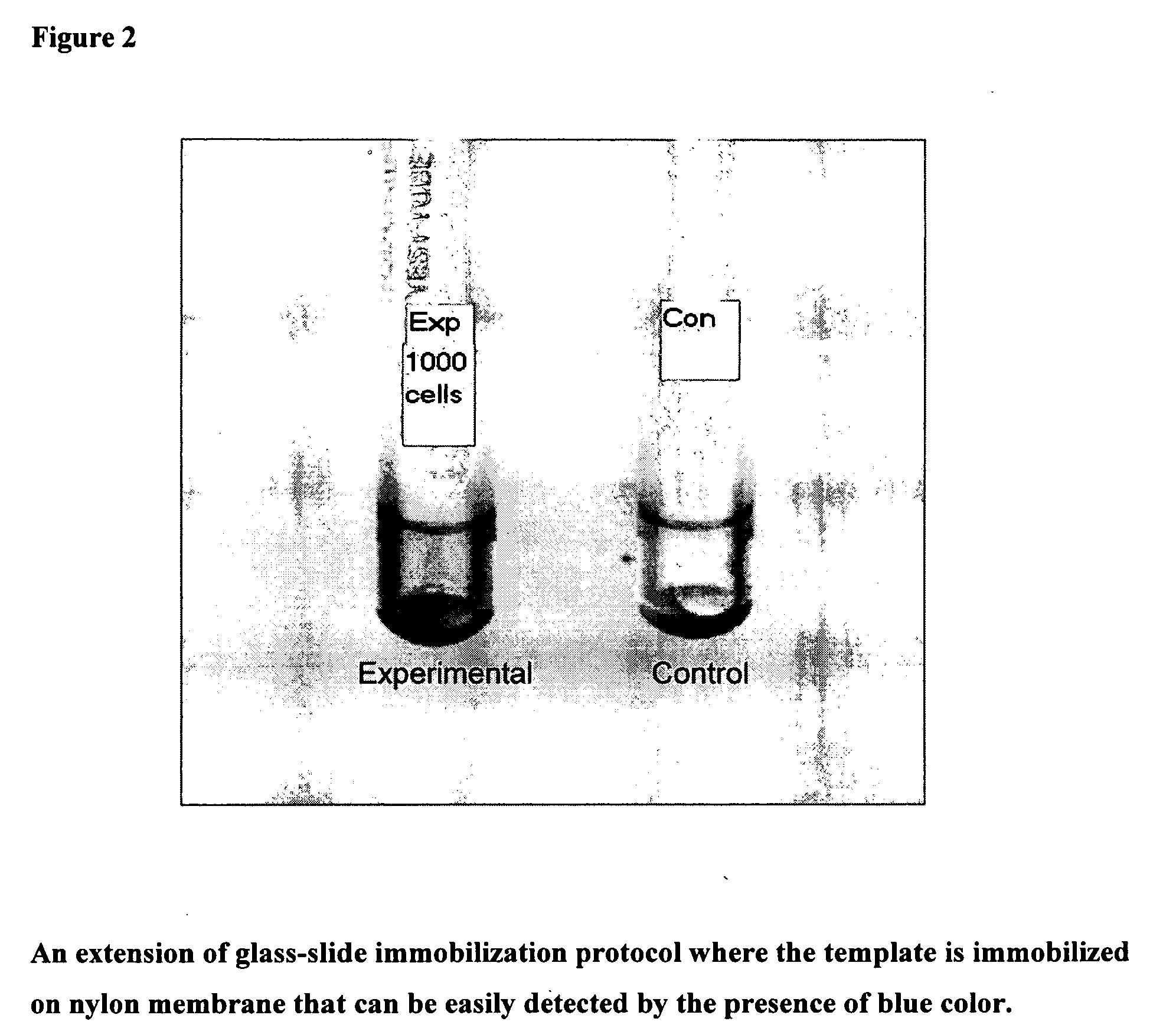Method for detecting the presence of water born pathogens and indicator microorganism
a technology of indicator microorganisms and pathogens, which is applied in the field of detection of water born pathogens and indicator microorganisms including bacteria, can solve the problems of time-consuming and labor-intensive conventional methods for detection of bacterial contamination in water samples, contamination of clean potable water, and inability to routinely monitor water samples for possible contamination
- Summary
- Abstract
- Description
- Claims
- Application Information
AI Technical Summary
Problems solved by technology
Method used
Image
Examples
example-1
96 Well Plate Protocol was Optimized for Detection of 1000 Cells:
[0058]Activation of the plate with TBS-SDS
[0059]Cells+DDW+NaOH—in eppendorff
[0060]Printing buffer+reaction mixture from the eppendorff
[0061]Incubate for 30 min
[0062]Wash twice with water
[0063]Block with hybridization buffer—30 min RT
[0064]Aspirate and add denatured probe (5, 10, 20 μl; 35 ng / μl) 5 min 95° C.
[0065]After this incubation put immediately on ice
[0066]Wash with 1×SSC pH 7
[0067]SAP 1:500 dil. RT for 30 min.
[0068]Wash twice with TBS-tween 20 buffer
[0069]Substrate (NADPH)—10 min in dark at RT
[0070]Amplifier—10 min in dark at RT
[0071]The well containing cell appears pink colored.
Following sets of variation in protocol tried at the selected steps:
[0072]1. 500 and 1000 cells, diluted NADPH substrate[0073]No color change
[0074]2. 1000 cells, substrates tried ELISA BRL and 10 mM NADPH, probe (5,10,20 μl)[0075]Dark pink color in BRL substrate and light pink in NADPH substrate.
[0076]3. Same as above except NADPH (100 m...
example-2
Nylon Membrane or FTA Filter as Immobilizing Matrix for Template:
[0090]Blotting and development procedure:
[0091]Nylon membrane strip was cut
[0092]E.coli Cells were incubated with 0.5N NaOH for 30 min at room temperature (RT) in eppendorff tubes
[0093]To this reaction mixture printing buffer was added
[0094]The reaction mixture was spotted on the nylon membrane
[0095]Template immobilization was done by UV cross linking
[0096]Wash membrane with 100 mM Tris pH 8.0
[0097]Pre hybridize for 10 min
[0098]Block with blocking agent
[0099]Denatured probe (5, 10, or 20 μl; 50 ng / μl) 5 min 95° C.
[0100]Aspirate and hybridize membrane bound template with the probe for 1 h at 60° C.
[0101]Wash the blot in a fresh tube with 2×SSC
[0102]1:1000 diluted SAP, in hybridization buffer for 10 min at RT
[0103]Wash with TBS
[0104]Cut the paper and put in the eppendorff
[0105]Treat it with substrate and amplifier
[0106]Observe pink coloration for colorimetric analysis
Following sets of variation in protocol tried at the s...
example-3
Hybridization Protocol for 1000 Target Cells of E.coli
[0191]Composition of the buffers used for this protocol:
[0192]1. Hybridization buffer: 1M Sodium phosphate buffer pH 7.2-250 ml [33.5 g Na2HPO4, 1 ml ortho-phosphoric acid (85% H3PO4)][0193]Add 1 ml 0.5M EDTA pH 8.0[0194]Add 5 g BSA[0195]14% SDS—250 ml.
[0196]2. 2×SSC (500 ml): NaCl—8.76 g[0197]Trisodium citrate—4.11 g[0198]DDW—400 ml.
[0199]3. TBS—Tween20: 1M Tris—25 ml[0200]5M NaCl—7.5 ml[0201]Tween 20—125 μl
[0202]4. Blocking buffer: 1.5% BSA—0.15 g BSA in 10 ml of TBS
[0203]5. Tris NaCl SDS: Tris (100 mM)—1.2114 g %
[0204]Buffer pH 8.0 NaCl (150 mM)—0.8766 g %[0205]SDS—0.05%
Advantages:
[0206]The main advantages of the present invention are:
[0207]Handling and preparation of larger number of sample could be carried out on site.
[0208]DNA extraction protocol is rapid and doesn't require any expensive chemicals.
[0209]The invention not only considers viable bacteria but also targets viable but non-culturable bacteria, such as those str...
PUM
| Property | Measurement | Unit |
|---|---|---|
| termination time | aaaaa | aaaaa |
| termination time | aaaaa | aaaaa |
| pH | aaaaa | aaaaa |
Abstract
Description
Claims
Application Information
 Login to View More
Login to View More - R&D
- Intellectual Property
- Life Sciences
- Materials
- Tech Scout
- Unparalleled Data Quality
- Higher Quality Content
- 60% Fewer Hallucinations
Browse by: Latest US Patents, China's latest patents, Technical Efficacy Thesaurus, Application Domain, Technology Topic, Popular Technical Reports.
© 2025 PatSnap. All rights reserved.Legal|Privacy policy|Modern Slavery Act Transparency Statement|Sitemap|About US| Contact US: help@patsnap.com



